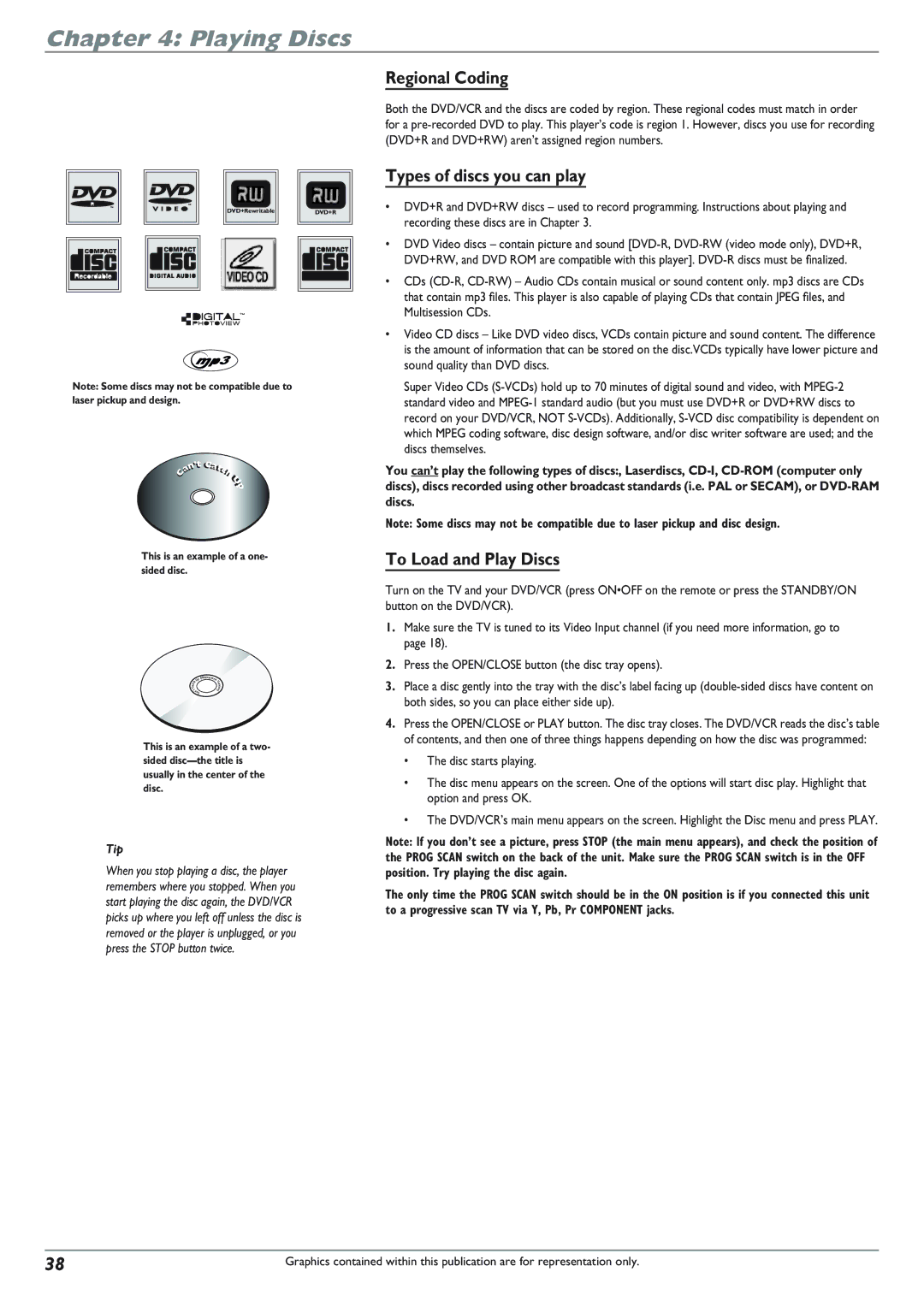
Chapter 4: Playing Discs
|
|
|
|
| DVD+Rewritable |
| DVD+R | ||
|
|
|
|
|
|
|
|
|
|
|
|
|
|
|
|
|
|
|
|
|
|
|
|
|
|
|
|
|
|
|
|
|
|
|
|
|
|
|
|
|
|
|
|
|
|
|
|
|
|
|
|
|
|
|
|
|
|
|
|
|
|
|
|
|
|
|
|
|
|
Note: Some discs may not be compatible due to laser pickup and design.
|
| 't | Ca |
|
|
|
| 't | tt |
| |
| n |
| |||
a |
|
| cc | ||
C |
|
|
|
| hh |
|
|
|
| UU | |
|
|
|
|
| p |
|
|
|
|
| p |
This is an example of a one- sided disc.
|
|
| d |
|
| p(Wi escree | |
c | h | U | nV |
| r | ||
at |
|
| e |
|
| s | |
C |
| i | |
t | no | ||
| 'n | ) | |
|
| aC |
|
This is an example of a two- sided
Tip
When you stop playing a disc, the player remembers where you stopped. When you start playing the disc again, the DVD/VCR picks up where you left off unless the disc is removed or the player is unplugged, or you press the STOP button twice.
Regional Coding
Both the DVD/VCR and the discs are coded by region. These regional codes must match in order for a
Types of discs you can play
•DVD+R and DVD+RW discs – used to record programming. Instructions about playing and recording these discs are in Chapter 3.
•DVD Video discs – contain picture and sound
•CDs
•Video CD discs – Like DVD video discs, VCDs contain picture and sound content. The difference is the amount of information that can be stored on the disc.VCDs typically have lower picture and sound quality than DVD discs.
Super Video CDs
You can’t play the following types of discs:, Laserdiscs,
Note: Some discs may not be compatible due to laser pickup and disc design.
To Load and Play Discs
Turn on the TV and your DVD/VCR (press ON•OFF on the remote or press the STANDBY/ON button on the DVD/VCR).
1.Make sure the TV is tuned to its Video Input channel (if you need more information, go to page 18).
2.Press the OPEN/CLOSE button (the disc tray opens).
3.Place a disc gently into the tray with the disc’s label facing up
4.Press the OPEN/CLOSE or PLAY button. The disc tray closes. The DVD/VCR reads the disc’s table of contents, and then one of three things happens depending on how the disc was programmed:
•The disc starts playing.
•The disc menu appears on the screen. One of the options will start disc play. Highlight that option and press OK.
•The DVD/VCR’s main menu appears on the screen. Highlight the Disc menu and press PLAY.
Note: If you don’t see a picture, press STOP (the main menu appears), and check the position of the PROG SCAN switch on the back of the unit. Make sure the PROG SCAN switch is in the OFF position. Try playing the disc again.
The only time the PROG SCAN switch should be in the ON position is if you connected this unit to a progressive scan TV via Y, Pb, Pr COMPONENT jacks.
38 | Graphics contained within this publication are for representation only. |
